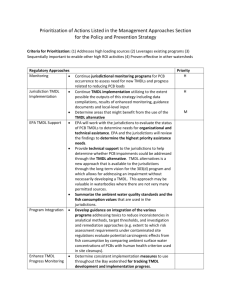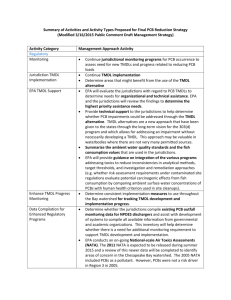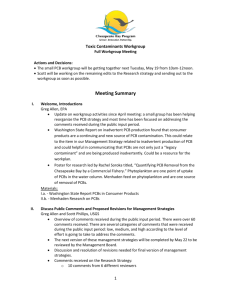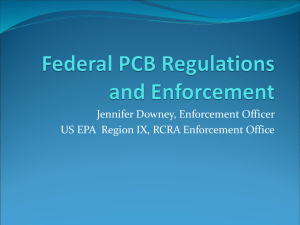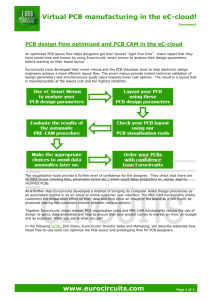TCW policy and prevention workplan draft_Nov 2
advertisement
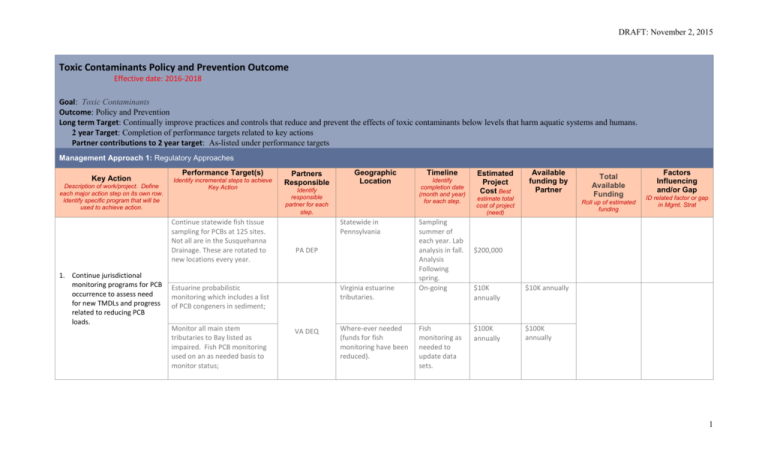
DRAFT: November 2, 2015 Toxic Contaminants Policy and Prevention Outcome Effective date: 2016-2018 Goal: Toxic Contaminants Outcome: Policy and Prevention Long term Target: Continually improve practices and controls that reduce and prevent the effects of toxic contaminants below levels that harm aquatic systems and humans. 2 year Target: Completion of performance targets related to key actions Partner contributions to 2 year target: As-listed under performance targets Management Approach 1: Regulatory Approaches Key Action Description of work/project. Define each major action step on its own row. Identify specific program that will be used to achieve action. Performance Target(s) Identify incremental steps to achieve Key Action Continue statewide fish tissue sampling for PCBs at 125 sites. Not all are in the Susquehanna Drainage. These are rotated to new locations every year. 1. Continue jurisdictional monitoring programs for PCB occurrence to assess need for new TMDLs and progress related to reducing PCB loads. Partners Responsible Identify responsible partner for each step. Statewide in Pennsylvania PA DEP Estuarine probabilistic monitoring which includes a list of PCB congeners in sediment; Monitor all main stem tributaries to Bay listed as impaired. Fish PCB monitoring used on an as needed basis to monitor status; Geographic Location Virginia estuarine tributaries. VA DEQ Where-ever needed (funds for fish monitoring have been reduced). Timeline Identify completion date (month and year) for each step. Sampling summer of each year. Lab analysis in fall. Analysis Following spring. On-going Fish monitoring as needed to update data sets. Estimated Project Cost Best Available funding by Partner estimate total cost of project (need) Total Available Funding Roll up of estimated funding Factors Influencing and/or Gap ID related factor or gap in Mgmt. Strat $200,000 $10K annually $10K annually $100K annually $100K annually 1 DRAFT: November 2, 2015 TMDL source investigation studies included where PCB TMDL being developed. Includes sediment monitoring and low level water column samples. Continue annual PCB monitoring in support of PCB TMDL development. Monitoring includes collection of water column (non-tidal/tidal), sediment and fish tissue samples for PCB analysis to support the development of water quality models in establishing PCB TMDLs. Continue annual PCB fish tissue monitoring for MDE’s Fish Consumption Advisory Program to assign state-wide fish consumption advisories. The program also provides fish tissue data for MDE’s Environmental Assessments and Standards (EASP) and TMDL Programs to support Integrated Report listing assessment and TMDL development. Conduct fish tissue study. Complete toxics monitoring on sediments in the Anacostia. MDE Tidal James River and tributaries, Elizabeth River and tributaries 2017 $25-50K $25-50K 303(d) New Vision TMDL Prioritization Plan: Potomac River (Montgomery County) Potomac River (Frederick County) 2018 $150,000 $150,000 State-wide Annually $100,000 Yes District of Columbia 9/30/2017 DOEE (WQDESA). Develop new and improved data sets to estimate atmospheric deposition contribution (and use 2 DRAFT: November 2, 2015 the result to update model input data). Approximately every five years, West Virginia performs a statewide fish tissue assessment to inform both fish consumption advisory and 303(d) listing processes. Mercury and PCBs will be analyzed. Potomac River PCB implementation - includes point sources and MS4s. Point sources that exceed WLAs will submit PMPs. 2. Continue TMDL implementation utilizing to the extent possible the outputs of this strategy including data compilations, results of enhanced monitoring, guidance documents and local-level input Tidal James/Elizabeth Rivers – point sources that have not screened effluents using the low level method will be required to do so. Facilities that have screened their effluents and exceed their WLA will be required to submit PMPs. Phase 1 MS4’s which have been assigned a WLA within a PCB TMDL requiring a PCB load reduction are required to develop a PCB Implementation Plan within one year of an approved TMDL. Five stream and three lake stations in the Potomac basin. Ongoing; Reassessment planned for 2016 Virginia’s embayments in the Potomac River. On-going WV DEP Unknown VA DEQ Tidal James/Elizabeth Rivers and applicable tributaries On-going once TMDL is completed Unknown MD MS4’s Baltimore County, Baltimore City, and Montgomery County have developed implementation plans for various TMDLs including the Baltimore Harbor, the Back River, and the Anacostia River. On-going within one year of TMDL completion. County Specific 3 DRAFT: November 2, 2015 Finalize the District Consolidated TMDL Implementation Plan, and incorporate elements into District’s next MS4 Permit. Implement stormwater BMPs and green infrastructure to meet TMDL IP’s first set of 5year milestones. 3. Develop guidance on integration of the various programs addressing toxics to reduce inconsistencies in analytical methods, target thresholds, and investigation and remediation approaches (e.g. extent to which risk assessment requirements under contaminated site regulations evaluate potential carcinogenic effects from fish consumption by comparing ambient surface water concentrations of PCBs with human health criterion used in site cleanups). District of Columbia On-going DOEE, DDOT, DGS, and Federal Landholders Make a recommendation that STAC (or other partner such as the Interstate Technology and Regulatory Council or ASTSWMO) assemble a workshop of experts to discuss the integration of analytical methods, target thresholds and investigation/remediation approaches to achieve consistency. TCW Develop a “white paper” based upon the outcome of the workshop (e.g. formation of an expert panel). STAC/Other Partner Determine status of efforts to coordinate these processes at a national level and stay informed of/participate in those conversations. TCW Bay watershed-wide To be determined Yes Approximately $9 million annually from DOEE Stormwater Enterprise Fund To be determined 4 DRAFT: November 2, 2015 4. Determine consistent implementation measures to use throughout the Bay watershed for tracking TMDL development and implementation progress. 5. Determine whether the jurisdictions compile existing PCB outfall monitoring data for NPDES dischargers and assist with development of systems to compile all available information from governmental and academic organizations. This inventory will help determine whether there is a need for additional monitoring requirements to support TMDL development and implementation. Develop maps to track locations where PCB TMDLs are active, under development, and needed. CBP GIS team and Bay watershed jurisdiction GIS leads Assess available information on identified management action implementation and determine next steps (e.g. status of npdes permits with regards to inclusion of PMP; MS4 action plans to ID potential IDDE connections to PMPs) Reasonable potential analysis during permit reviews includes PCBs TCW and Bay watershed jurisdictions PA Statewide in Pennsylvania Virginia has an Access Database used to store PCB data obtained from a wide array of matrices (sediment, water, effluent, etc.). The database structure, obtained from DRBC, was designed specific to storing data analyzed and reported using method 1668 including 209 PCB congeners (aka DRBC protocol). Compile an issue paper to describe the current state of monitoring and outline the roadblocks to enhancing those monitoring programs. VA Statewide in Virginia TCW Bay watershed-wide Bay watershed-wide 2016 No specified time. New permits and as permit renewals come due. NA To be determined 5 DRAFT: November 2, 2015 6. EPA conducts an on-going National-scale Air Toxics Assessments (NATA). The 2011 NATA will be reviewed upon release to identify the sources of and exposures to air toxics, including PCBs, within the Chesapeake Bay watershed. 7. Assess the information that is available and forthcoming (e.g., the characterization of Anacostia river sediments by DC Department of Energy and Environment) that describes the most highly contaminated in-stream sediments in the watershed to engage the jurisdictions and federal regulators to explore the feasibility of additional remedial actions such as capping and/or dredging. Conduct a thorough review of the 2011 NATA report. Determine additional activities that could be helpful in determining where more atmospheric source data is needed. Develop a final Remedial Investigation Report (RI Report) based on the 700 samples already collected along the 9mile tidal portion of Anacostia River between FY14 and end of FY15. TCW DOEE and federal partners Bay watershed-wide 1. District of Columbia (CSOs, MS4, streams, etc.). To be determined Draft RI Report- Dec 2015; FS Report Sep 2016. $8M Unknown $9M 6 DRAFT: November 2, 2015 8. The EPA Region 3 HSCD Site Assessment program will continue to track sites that are being evaluated in the Chesapeake Bay Watershed. Study brown bullhead tumors in tidal Potomac River and Anacostia River between 20142016, establish trends, if any, and to determine whether or not any established trends are local or regional; ). DOEE and FWS Potomac River and Anacostia River Annual Report 2015, 16 and 17 $200K $200K Install gauging and sampling stations in NW Branch, NE Branch and Lower Beaver dam Creek. Sampling storms by collecting sediment samples using innovative USGS tested methods to calculate loads for six episodes. DOEE and USGS NW Branch, NE Branch and Lower Beaver dam Creek. Annual Report of findings from upstream monitoring $170K $150K Collect data to identify sources and characterize contributions from those sources, including CSOs, MS4 outfalls, streams, and upstream contributions. DOEE and USGS District of Columbia Annual Report Dec 2016 $250K $150K Ongoing tracking in SEMS of work in Ches. Bay Watershed Site assessment decision forms have been updated to include checkbox on whether site is in EPA HSCD EPA R3 office Ongoing EPA FTE – GIS contractor – est. $15,000 Data compilation for Enhanced Regulatory Programs 7 DRAFT: November 2, 2015 Additionally, a GIS desktop tool is being developed to assist HSCD in identifying potential land sources of contamination in the watershed. This project is not limited to PCBs, but any type of contamination that could be migrating from CERCLA sites and affecting the watershed. The GIS tool will help to identify potential CERCLA sites and their proximity to environmentally sensitive areas and receptors to better focus on priority site evaluations. The use of EJ SCREEN will be evaluated to identify the location of such sites in areas with diverse populations. 9. The HSCD Site Assessment Program will conduct work share meetings with our State counterparts once per year to determine who will be the lead agency for further investigation of any potential PCBs sites that are on the active sites list. Ches. Bay Watershed, and/or priority areas (Baltimore Harbor, Anacostia, Elizabeth River) Meet with CBO GIS team to go over available data layers that might be of use to site discovery effort - Site Assessment Mapper (SAM) GIS tool is completed and ready for use – EJscreen is a data layer in SAM EPA HSCD, TCW Provide information to TCW for potential GIS mapping on CERCLA NPL sites in the watershed that may be undergoing PCB remediation. EPA HSCD During yearly workshare meeting, TCW workplan will be a discussion point at the meetings and will use the initiative in the prioritization of sites to be evaluated in the CA HSCD, State Site Assessment Counterparts R3 or CBO Sept Oct/2015 Meetings held either at State offices/ EPA R3/conf. calls Dec. 2016 Funding would come from EPA PA/SI Cooperative Agreement Budget Unknown 8 DRAFT: November 2, 2015 Also, other sites identified in #10 below or by other methods in trackdown studies, etc. may be better addressed under State VCP or other State programs. This will also be discussed at workshare meetings. 10. HSCD and TCW will continue to evaluate sites to identify industries or processes that used PCBs. Once this list is generated, the CERCLA, Brownfields, and RCRA programs can better focus resources on identifying and investigating these types of sites. As significant sources of PCBs, or other contaminants that are migrating into the watershed from contaminated land sources are discovered, HSCD will share this information as part of the progress monitoring of this strategy. Additionally, if there are potential land sources that other programs have found, HSCD can investigate those potential sources through coordination with the appropriate authority. Identification and mapping of potential industries that historically used PCBs in the watershed State/VCP program budgets March 2016 HSCD, TCW, TSCA EPA FTE Discuss potential PCB sources with TCW and TSCA (e.g., power plants, railroad maintenance yards, etc.) Identify locations of industries within the watershed that may be potential PCB sources Oct/Nov 2015 HSCD Nov/Dec 2015 HSCD Preremedial 9 DRAFT: November 2, 2015 Obtain information on PCB hotspot areas within the watershed and try to correlate CERCLA sites or other sites identified from above with those hotspots. Use information and data generated from above to prescreen and prioritize sites to determine whether further assessment is needed and by whom. HSCD, TCW March 2016 pipeline funding April 2016-Dec 2017 11. The EPA R3 NPDES Permits Branch will continue to address PCBs through the CWA framework. Where waters have been identified as impaired and a TMDL has been established creating WLA for point sources, the NPDES Permitting program will ensure that permits are consistent with the TMDL. The NPDES Permitting Program will draft and review permits with a focus on ensuring that PCB WLAs are clear and enforceable. The NPDES Enforcement Program, through state oversight and its independent compliance monitoring and enforcement authorities, will ensure that permit requirements are met. If a permittee is in noncompliance with its compliance obligations, EPA 10 DRAFT: November 2, 2015 will take timely and appropriate action, including exercising its enforcement authority, to ensure that the permittee returns to compliance in an expeditious manner. 12. The EPA R3 Land and Chemicals (LCD) Toxics Program Branch will continue to ensure compliance with PCB TSCA regulations through its PCB inspection and enforcement program. Inspections will be targeted based on potential for releases, cumulative burden on EJ communities, or permitting. The R3 Toxics Program Branch will also responds to on tips/complaints that involve potential for illegal disposal and significant risk. 13. The EPA R3 LCD Office of Materials Management will continue to partner with the Maryland Department of Environment to oversee the PCB clean up at the Lockheed Martin plant located in Middle River, Maryland. The Middle River facility, which is located on Cowpen Creek, is considered to be a major contributor to PCBs in the Bay. Phase 2 of the clean-up is commencing. In 2016 and 2017, the EPA R3 LCD Toxics Program will perform inspections at facilities within the R3 states based on potential for PCB releases, cumulative burden on EJ communities, or permitting. The R3 Toxics Program Branch will also responds to on tips/complaints that involve potential for illegal disposal and significant risk. EPA Region 3 Land and Chemicals Division Region 3 states with a focus on the Chesapeake Bay Watershed 2016-2018 Overall performance target is completion of remedial actions specified in the Feasibility Study approved by MDE and EPA Region III. Incremental steps include permit applications, approvals, mobilization, sediment removal, confirmatory sampling, in situ treatment amendment application, postclosure bioaccumulation monitoring, and a 5-year review submittal Lockheed Martin is performing the remediation under an Administrative Consent order with the MDE. The project will require EPA approval of a Risk Based Disposal Approval Application (RBDAA) to Middle River, Maryland. Waters immediately adjacent to the Lockheed Martin Middle River Complex facility including Dark Head Cove and Cow Pen Creek. Joint Permit Application submittal expected – November 2015 RBDAAs submittal expected – January 2016 All Permit Approvals for remediation n/a n/a $0 TBD n/a EPA Region III approval of RBDAA including remedial cleanup design, baseline and postremedy bioaccumulation monitoring program. Most in water work is restricted to be performed between October 15 and February 15 to 11 DRAFT: November 2, 2015 manage the PCB remediation waste, and a separate conditional RBDAA approval for the application and monitoring of in situ amendments to reduce the bioavailability of residual PCBs within Dark Head Cove. Permits to perform the remedial work will have to be secured from various entities of the MDE, U.S. Army Corps of Engineers (USACE), Baltimore County, etc. 14. EPA will publish the April 7, 2010 Advanced Notice of Proposed Rulemaking (ANPRM) in the Federal Register for Public Comment. The Proposed Rulemaking is to reassess the ongoing authorized uses of PCBs to determine whether certain use authorizations should be Publish the Advanced Notice of Proposed Rulemaking (ANPRM: April 7, 2010) in the Federal Register for Public Comment. EPA Office of Chemical Safety and Pollution Prevention, Office of Pollution Prevention and Toxics mobilization – October 2016 Completion of Dark Head Cove Sediment Removal – February 2017 Completion of Cow Pen Creek Sediment Removal – February 2018 Completion of in situ treatment amendment application – February 2018 Submittal of 5year review and in situ treatment effectiveness do National avoid fish spawning and sub-aquatic vegetation-based time of year restrictions hence the need for timely permit approvals. Proposed Rule FY 2016 N/A N/A N/A 12 DRAFT: November 2, 2015 ended or phased out because they can no longer be justified under section 6(e) of the Toxic Substances Control Act, which requires that the authorized use will not present an unreasonable risk of injury to health and the environment. Management Approach 2: Education and Awareness Key Action Description of work/project. Define each major action step on its own row. Identify specific program that will be used to achieve action. 1. Develop PMP guidance document for the control and reduction of PCBs in NPDES regulated stormwater and wastewater including an inventory of stormwater BMP options. This document would provide guidance to all Bay jurisdictions in implementing PCB load reductions established for dischargers through TMDL development while recognizing the need for flexibility in PMP design. Develop guidance for unregulated sources of PCBs for use in developing Performance Target(s) Identify incremental steps to achieve Key Action Contingent upon completion of VA DEQ’s work to evaluate and assess cross-jurisdiction applicability Partners Responsible Geographic Location Identify responsible partner for each step. VA DEQ Bay watershed-wide Timeline Identify completion date (month and year) for each step. Estimated Project Cost Best estimate total cost of project (need) Available funding by Partner Total Available Funding Roll up of estimated funding Factors Influencing and/or Gap ID related factor or gap in Mgmt. Strat To be determined 13 DRAFT: November 2, 2015 implementation plans under TMDLs. 2. 3. Working with local government and non-profit organizations, the TCW will inform the public regarding risks from consuming contaminated fish by developing communications materials and corresponding procedures for their dissemination throughout the targeted communities. Compile education materials regarding existing procedures and best practices for containment and prevention of release of PCBs. Secure GIT Project funding. Diversity Action Team Inventory existing approaches to issuing fish consumption advisories and study effectiveness of and compliance with those advisories in order to develop enhanced tools Test the new tools and work on optimization Project award recipient in coordination with DAT and TCW February 2016 Project award recipient in coordination with DAT and TCW Bay Program partners MarchNovember 2016 Implement and disseminate new tools in order to explore the extent to which diverse populations are located in areas where fish advisories are being issued, using EPA’s EJSCREEN tool. Identify potential resources Compile education materials TCW Bay watershed-wide October 2015 $50,000 December 2016 Bay watershed wide To be determined Contingent upon available resources Management Approach 3: Voluntary Programs Key Action Description of work/project. Define each major action step on its own row. Identify specific program that will be used to achieve action. Performance Target(s) Identify incremental steps to achieve Key Action Partners Responsible Identify responsible partner for each step. Geographic Location Timeline Identify completion date (month and year) for each step. Estimated Project Cost Best estimate total cost of project (need) Available funding by Partner Total Available Funding Roll up of estimated funding Factors Influencing and/or Gap ID related factor or gap in Mgmt. Strat 14 DRAFT: November 2, 2015 1. Coordinate a voluntary action program to reduce transformers and other PCB containing equipment (e.g., fluorescent light ballasts). Include those classified as PCB free (less than 50 ppm) Provide to program participants information on remediating PCB contamination on-site from historical releases of these transformers and use EPA’s EJ SCREEN tool to help identify where such equipment is located in areas with diverse populations. Identify a project lead TCW Estimate location and volume of PCB-containing equipment Contingent upon available resources Estimate costs of replacing PCBcontaining equipment Contingent upon available resources Identify potential incentives and present summary of cost information to land owners Contingent upon available resources Obtain commitment from land owners to voluntarily replace PCB containing equipment with consideration to include activities in areas with diverse populations Contingent upon available resources Bay watershed wide To be determined Management Approach 4: Science Key Action Description of work/project. Define each major action step on its own row. Identify specific program that will be used to achieve action. 1. Support research on costeffective tools for track-down studies and provide a Performance Target(s) Identify incremental steps to achieve Key Action Secure resources Partners Responsible Geographic Location Identify responsible partner for each step. TCW Bay watershed-wide Timeline Identify completion date (month and year) for each step. To be determined Estimated Project Cost Best estimate total cost of project (need) Available funding by Partner Total Available Funding Roll up of estimated funding Factors Influencing and/or Gap ID related factor or gap in Mgmt. Strat $50,000 15 DRAFT: November 2, 2015 mechanism for municipalities to share information on lessons learned from PMP development and implementation strategies and methods for documenting and sharing the information. 2. Identify barriers and opportunities related to more frequent use of EPA 1668 for contaminated sites, wastewater and regulated and unregulated stormwater dischargers as a screening tool (as is underway in VA) or for a targeted subset of permittees. This effort could also be targeted to industrial stormwater permittees with SIC classifications that indicate the facility has the potential for PCB contamination on site from historical use or current operation or disposal of PCB containing materials. 3. Encourage use of the highsensitivity congener-based methods to analyze PCBs to ensure that PCB sources are being characterized accurately when such characterization can help with source identification 4. A project was completed to determine the relative Conduct interviews, literature reviews and hold a technical workshop to gather information on best practices. Develop a guidance document on best practices for effective implementation of PCB track down studies in the TMDL context Apply for a STAC workshop or identify additional potential resources Contingent upon resources TCW Bay watershed-wide 2016 Identify a funding source to achieve this item. TCW Bay watershed-wide To be determined (1) Estimate the potential toxic contaminant reduction Chesapeake Stormwater Bay-wide Contingent upon resources 16 DRAFT: November 2, 2015 amount of PCB reduction that might occur across the range of BMPs implemented for the Chesapeake Bay nutrient and sediment TMDL. The BMPs will be crosscorrelated with contaminant pathways and their association with land use and industrial sources (e.g., urban stormwater, agriculture, landfills, dredged material disposal facilities, hazardous waste sites, and industrial operations). The study assessed and explained the most beneficial management actions that could leverage current TMDLs and watershed implementation plans (WIPs) to achieve multiple benefits for nutrient, sediment, and toxic contaminant reductions. 5. Review the 2015 NATA report to determine the need for further investigation of atmospheric sources of PCBs, characterization of PCB concentrations in atmospheric deposition to the watershed and Bay, and determine the significance of these sources for bioaccumulation in fish. Homolog distribution profiles associated with the implementation of BMPs for sediment and nutrient reduction under the Chesapeake Bay TMDL. Network and TCW (2) Provide water resource managers with better BMP data to develop more effective local TMDLs to control toxic pollutants in the watershed. (3) Recommend specific stormwater treatment and pollution prevention practices that could maximize removal of toxic contaminants in the Bay watershed Review NATA report TCW Bay watershed-wide To be determined Review atmospheric deposition study based in Delaware estuary 17 DRAFT: November 2, 2015 for PCBs in atmospheric deposition could be evaluated to determine whether mid-weight congeners are present at levels that significantly contribute to bioaccumulation in fish. Analyze need for next steps 18


